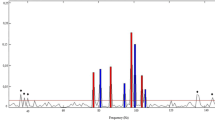Abstract
The auditory steady-state responses to single continuous tones modulated in amplitude have been proposed as an alternative to objective frequency-specific audiometry. The aim of this study was to compare thresholds obtained by pure-tone audiometry (PTA) and by auditory steady-state responses in normal hearing or affected by hearing loss in adults and in order to evaluate the applicability of this objective test in no collaborative hearing-impaired subjects. Eleven people, 6 normal hearing and 5 with hearing loss, underwent PTA and multiple frequency auditory steady-state responses; simultaneous carrier tones (0.5, 1, 2 and 4 KHz) modulated in amplitude at different rates (77–105 Hz) were presented monaurally (TDH 49 earphones) at variable intensities (110–20 dB SPL). The mean threshold difference between PTA and multiple frequency auditory steady-state responses was 28 dB (standard deviation=14.2) and R correlation value at 0.5-1-2-4 kHz was 0.71 (P=0.0012) at the Pearson’s test. These differences were significantly smaller considering the hearing-impaired separately (11.7 dB, standard deviation=2.9). The results of this study confirm previous reports showing that the multiple auditory steady-state response method is an accurate predictor of the behavioural audiogram in patients with sensory-neural hearing impairments and can be used as a valid support for behavioural evaluations.

Similar content being viewed by others
References
Albera R, Canale G, Magnano M, Lacilla M, Morra, Rugiu MG, Cortesina G (1991) Relationship between pure-tone-audiometry and slow vertex responses. Acta Otorhinol Ital 11:551–562
Albera R, Roberto C, Magnano M, Lacilla M, Morra B, Cortesina G (1991) Evaluations on slow vertex response waveform identification. Acta Otorhinol Ital 11:543–549
Cohen LT, Rickards FW, Clark GM (1991) A comparison of steady-state potentials to modulated tones in awake and sleeping humans. J Acoust Soc Am 90:2467–2479
Dimitrijevic A, John M, Picton W (2004) Auditory steady-state responses and word recognition scores in normal-hearing and hearing-impaired adults. Ear Hear 25:68–84
Herdman AT, Stapells D (2003) Auditory steady state response thresholds of adults with sensorineural hearing impairments. Int J Audiol 42:237–248
Hood LJ (1998) Clinical applications of the ABR in neurological testing. In: Clinical applications of the auditory brainstem response, Singular Publishing Group Inc., San Diego–London, pp 67–91
John MS, Brown DK, Muir PJ, Picton TW (2004) Recording auditory steady-state responses in young infants. Ear Hear 25:539–553
Lins OG, Picton TW, Boucher BL, Darieux-Smith A, Champagne SC (1996) Frequency-specific audiometry using steady state responses. Ear Hear 17:81–96
Luts H, Wouters J (2004) Hearing assessment by recording multiple auditory steady state responses: the influence of test duration. Int J Audiol 43:471–478
Perez-Abalo MC, Savio G, Torres A, Martin V, Rodriguez E, Galan L (2001) Steady state responses to multiple amplitude modulated tones: an otimized method to test frequency-specific threshold in hearing-impaired children and normal hearing subjects. Ear Hear 22:200–211
Picton TW (1978) The strategy of evoked potentials audiometry. In: Gerber SE, Mencher GT (eds) Early diagnosis of hearing loss. Grune & Strutton, New York, pp 279–308
Picton TW, Darieux-Smith A, Champagne SC, Whittingham J, Moran LM (1998) Objective evaluation of aided threshold using auditory steady state responses. J Am Acad Audiol 9:315–331
Rance G, Rickards FW, Cohen LT, De Vidi S, Clark GM (1995) Automated prediction of hearing threshold in sleeping subjects using auditory steady-state evoked potentials. Ear Hear 16:499–507
Stapells DR (2002) The tone-evoked ABR: why it’s the measure of choise for young infants. Hear J 55:14–18
Stapells DR, Picton TW, Perez-Abalo MC, Read D, Smith A (1985) Frequency specificity in evoked potential audiometry. In: Jacobson JT (ed) The auditory brainstem response. College Hill Press, San Diego, pp 147–177
Author information
Authors and Affiliations
Corresponding author
Rights and permissions
About this article
Cite this article
Canale, A., Lacilla, M., Cavalot, A.L. et al. Auditory steady-state responses and clinical applications. Eur Arch Otorhinolaryngol 263, 499–503 (2006). https://doi.org/10.1007/s00405-006-0017-y
Received:
Accepted:
Published:
Issue Date:
DOI: https://doi.org/10.1007/s00405-006-0017-y




